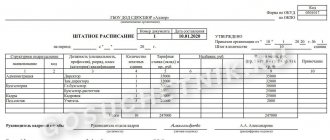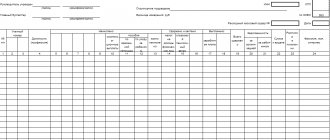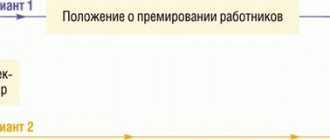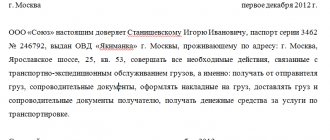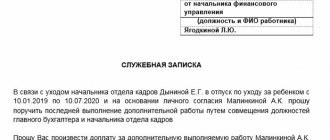Settlements with accountants
Accountable amounts include not only advances for travel expenses, but also the issuance of money for the purchase of office and household goods, fixed assets, fuels and lubricants, food and other expenses for the needs of the institution.
Reporting funds can only be issued to employees with whom employment contracts have been concluded. It will not be considered an error to issue funds to an employee working under a civil contract, for example, for the purchase of building materials. In small organizations, it is permissible to issue an order that specifies specific officials and names to whom it is permissible to provide money against an advance report. Below you will find a sample order for the appointment of accountable persons 2020.
A budgetary institution must establish a limit on settlements with accountable persons and a maximum period for which money is issued. The legislation does not indicate restrictions on terms and amounts; therefore, the organization independently determines the rate of funds issued against the advance report and the terms.
The deadline for submitting the advance report is no later than three working days, established by clause 6.3 of Instructions No. 3210-U. The institution does not have the right to approve a longer period. And if the organization does not have an order on the timing of reporting on accountable amounts, then employees are required to report on the day the reporting period ends (the period for which the money was issued) or on the first working day (upon returning from a business trip).
Additional Information
Change is ok
List of changes made in 2020 to the procedure for issuing accountable amounts:
- Money can be issued to personnel who work not only under an employment agreement, but also under a civil law one.
- The employee’s application is the only basis for issuing funds. Previously, the head of the organization had to write the amount of funds and the deadline for issuing them in his own hand, but now there is no such need, and the application can be drawn up electronically.
- The issuance of funds is possible only if there is no debt on previous amounts.
- It is now possible to transfer accountable funds from an organization’s account to an employee’s card.
- All transactions with accountable funds must be recorded in tax and accounting records.
- The advance report must be submitted within the established time frame. Failure to meet deadlines may result in additional personal income tax assessment.
- When preparing an advance report, form AO-1 is used.
Form AO-1 in word format
An application for the issuance of cash on account is submitted by those persons who were previously approved by the director as accountable. 2020 income tax returns can be found here.
How to avoid fines and liability
There is no fine for violation of cash discipline, but during tax audits the organization may be arrested for the following reasons:
- violation of the procedure in accordance with which available cash should be stored;
- violation of the order in accordance with which cash transactions should be conducted.
The collection of a fine for such reasons and due to the lack of an application can be challenged in court.
During a tax audit, one day is given to provide all necessary documents. During this day, all missing applications for funds can be processed. They will need to be attached to the RKO.
There is a statute of limitations for imposing administrative liability for violation of cash discipline. In paragraph 1 of Art. 4.5 of the Code of Administrative Offenses states that it is equal to two months, so applications need to be drawn up only for the last two months before the tax audit.
Sample of filling out an order for the issuance of money for reporting to the manager
Rules and features
There are fixed rules in accordance with which the procedure for issuing accountable funds should be carried out:
- The issuance of funds can only be carried out in cases where the funds are spent on purposes that relate to the activities of the organization.
- Either a labor or civil law agreement must be concluded between the employee and the organization. Only upon conclusion of an agreement can an employee receive accountable money.
- A prerequisite is confirmation of the application for the issuance of funds from the head of the enterprise. If the funds were transferred to the employee’s card, then the relevant documents must also be submitted.
- The transfer of funds to both the manager and other employees must occur when registering cash settlements.
- Funds will be issued only if the employee has no debt. After receiving the funds, you will need to submit an expense report and all necessary documents.
- Submitted documents are subject to careful verification. After verification, the head of the company must set the period during which the issued amount must be repaid.
These rules apply to absolutely every employee of the organization, including the director.
Many specialists involved in this issue have problems in processing the issuance of funds to the head of the enterprise.
In such situations, the following features need to be taken into account:
- As stated in the Labor Code of the Russian Federation, the director of an organization has the same labor relations with it as other employees, therefore the process of issuing accountable funds to the director should not differ in any way from the standard process.
- The second feature is that the director of the enterprise must certify his application himself. In cases where an organization has several directors, the process of signing an application is much simpler: if funds need to be issued to one director, then another director has the right to certify his application.
It follows from this that the heads of organizations do not have any benefits when receiving funds on account: before receiving funds, they must go through all verification procedures, like other employees, and an order must also be drawn up for them to issue money on account to the manager.
Is it possible to do without the manager’s order?
The amendments to Bank of Russia Directive No. 3210-U dated March 11, 2014 abolished the requirement for an employee to submit an application for receipt and a manager’s order to disburse funds. Now you can issue money on the basis of either only an order from the manager, or an application from an employee with a resolution from the director.
In practice, most accounting and HR workers continue to require both documents. Why? One order is not enough for the auditor, since there is no calculation of the amount and justification for the purpose of the report. The inspector will definitely require you to justify the expenses incurred. And vice versa, many inspectors consider a statement with the director’s resolution, but without an official order, to be insufficient.
To eliminate problems with inspection authorities, tax officials recommend maintaining the old procedure for issuing an issue: drawing up both an application and an order.
General points of the order for the issuance of money for reporting to the manager
The issuance of accountable funds to the head of the organization is sometimes allowed on the basis of an order that will contain all the necessary information and will be addressed to the cashier. However, this is contrary to the law, and if the tax authorities raid an enterprise with an inspection, they can hold the organization accountable.
Funds can be issued for certain purposes, regulated by the instructions of the Central Bank of the Russian Federation:
- purchasing necessary items;
- payment of expenses spent on business trips;
- settlements under contracts.
There is also a certain algorithm for issuing money to an enterprise for reporting:
- Before accepting an application from an employee for the issuance of funds, you need to find out whether all of his previous similar debts have been repaid.
- If there is no debt, the employee must draw up an application for the issuance of money. If an employee has a debt, then he cannot receive new funds until he pays it off.
- The next step is the signing of the document by the head of the organization, after which the accounting department must draw up and sign the RKO.
- After this, the employee needs to apply with his passport and cash register to the company’s cash desk, and the funds will be issued to him. The RKO must be signed by both the cashier and the recipient.
- The last step is to enter this transaction into the cash book.
After receiving the funds, when the period for providing the funds expires, the employee must provide an advance report. It must be submitted to the accounting department. Accounting staff check where funds are used using supporting documents (checks, etc.).
Conditions that apply to supporting documents, namely checks:
- The name of the purchase and the details of the company must be clearly printed on cash receipts;
- the product must be purchased during business hours;
- The sales receipt must have both a stamp and a number.
The report is also checked for correctness. If there are no shortcomings, then the head of the enterprise will need to sign the document, after which the funds will be written off.
If not the entire amount issued has been spent, then the remainder is returned to the organization's cash desk. To do this, you need to issue a cash receipt order (PKO). If the employee does not have enough funds to achieve the set goal, then the entire amount of overspending must be sent to the employee to the account specified in the advance report. This operation must also be formalized by RKO.
The Labor Code of the Russian Federation states that if an employee has not returned accountable funds to the cash desk, then the organization has the right to withhold this amount from his salary. But the employee’s written consent must be given to this. If the employee does not consent to the recovery, it will be carried out on the basis of a court decision, but the recovery cannot be more than 20% of the employee’s salary.
As practice shows, issuing accountable amounts has other nuances, for example:
- if an employee needs to receive funds, but the manager is not at work, then the operation of issuing funds can be completed by an accountant or financial director on the basis of a power of attorney;
- many managers want to receive funds without an application, which is a gross violation, because funds must be issued based on the employee’s application, regardless of his position;
- an amount that exceeds the limit of 100,000 rubles is issued only in case of cash settlements with other enterprises.
Rules for drawing up a document
There is no unified form, but pay attention to the following rules:
- Create a document on the institution’s letterhead in a single copy. If such a form is not available, then in the header of the document indicate the name of the government agency (full), number, date and name of the order.
- A sample of a new order for reporting should be registered in the order register in the usual manner.
- When creating a new order, strictly follow the chronological order, otherwise the inspectors will suspect forgery.
- Only the head of the organization or his deputy or the person acting as head has the right to approve the document.
- In the document, be sure to indicate the following details: Accountable person: last name, first name and patronymic (if any), position.
- Subreport amount: indicate the amount in words and figures, in rubles and kopecks.
- Purpose: write down the specific purpose of the allocated money.
- Reporting deadline: indicate the deadline (day, month, year) until which the money was issued.
Don't forget to appoint a responsible person, for example, a chief accountant. If the organization does not have an accounting department, then control over compliance with this order should be entrusted to the manager.
Deadlines for issuing funds
As a general rule, an employee must report on the amounts received for reporting no later than three working days after the expiration of the period for which these amounts were issued (clause 6.3 of the Directive of the Central Bank of the Russian Federation dated March 11, 2014 No. 3210-U). But what to do if the return period has not been set? According to tax authorities, in such a situation the employee must submit the report on the same day on which they received them (letter of the Federal Tax Service of Russia dated January 24, 2005 No. 04-1-02/704).
Travel allowance report
Special conditions are defined for travel expenses. The employee must report on them within three working days from the date of return from a business trip (clause 26 of the Regulations, approved by Decree of the Government of the Russian Federation of October 13, 2008 No. 749).
An advance report is a document on the basis of which control of cash flows and the establishment of the fact of a business transaction take place, because with it primary documents confirming this fact are submitted to the accounting department.
It is necessary to write in the Regulations that the report in Form AO-1 must be submitted to the accounting department within 3 days after the last day of the period for which the money was received, or after the employee returns to work. If the report form is developed independently at the enterprise, taking into account its specifics, it is necessary to approve it by order of the manager, and write a clause about this in the Regulations.
It is recommended that a detailed description be made of what source documents must be submitted and how they must be completed in order for them to be accepted as evidence of expenditure incurred. It is often not enough to have one payment document - a cashier's check or a counterfoil for a cash receipt order. You may also need the following documents for purchased goods or services:
- in retail trade - sales receipt;
- in wholesale - delivery note and invoice;
- when paying for services - an agreement, an invoice, an acceptance certificate or a universal transfer document.
In this part of the Regulations, it is necessary to reflect the main points related to the advance report, after the preparation of which the employee, together with the primary documents attached to the report, submits it to the accounting department. In particular, these:
- The accountant fills out a receipt for the advance report and gives it to the employee.
- It is advisable to describe how the report itself and the documents attached to it are verified. Primary documents must contain the necessary details, correspond to the purpose and match the amount. Documents filled out incorrectly will not be accepted for accounting and will be reimbursed to the accountant.
- After checking and filling out his part of the report, the accountant sends the document for signature to the chief accountant, and then to the manager for approval.
- The period during which the report must be checked and approved, as well as the amounts for this analytical account must be closed, must be indicated in the Appendix. For example, a week is given to check and approve a report, and 2 business days are given to issue overruns or deposit the balance into the cash register after approval by the manager. If the balance of the account is not returned within the specified period, the enterprise has the right to withhold this debt from the salary of the accountable person in accordance with the law (Article 137.138 of the Labor Code of the Russian Federation).
How to correctly reflect the return in accounting, read the article “Return by an accountable person of the amount of an unspent advance.”
- If during the period for which accountable funds were issued, the employee did not purchase anything, then within 3 days after the period specified in the Regulations, the money in full must be returned to the organization.
- If an enterprise is active, as a result of which accountable amounts are regularly issued to a large number of employees, then for control and accounting it is recommended to carry out an inventory of settlements with accountable persons several times a year. This issue should also be covered in the Regulations.
For settlements with accountable persons regarding travel expenses, it is recommended to issue a separate Regulation on business trips, which should consider all the nuances of travel expenses and possible disagreements with accountable persons and tax authorities.
A sample of such Regulations can be found at the link.
The procedure for issuing accountable amounts
Enterprises in the process of financial and economic activities can issue certain amounts to their employees for reporting purposes.
Accountable amounts are cash advances issued by an enterprise from the cash register for administrative and business expenses, expenses for the purchase of spare parts, expenses for business trips, travel expenses for paid benefits leave, as well as various works and services for the operational activities of the enterprise.
Issuing money for reporting from the cash register in 2020: main rules
In such cases, the employee is usually given cash under his responsibility to perform certain actions on behalf of the organization.
Funds are issued on account for administrative and business expenses.
Administrative expenses are non-production overhead costs associated with the maintenance of administrative services and the management of the enterprise as a whole.
Administrative expenses include office, postal and telegraph expenses, purchases of materials through small wholesale retail trade, purchases of agricultural products and expenses for other operating needs.
Cash can be issued to employees from the organization's cash desk:
• either for reporting on business and operating expenses;
• or in order to reimburse expenses incurred by the employee from personal funds for the needs of the organization.
In accordance with the Procedure for conducting cash transactions, the issuance of cash from the organization's cash desk is carried out according to cash outgoing orders of the standard interdepartmental form KO-2 or duly executed other documents (pay slips, applications for the issuance of money, etc.) with a stamp affixed to these documents details of the cash receipt order.
When purchasing inventory items, the following entries are made:
If funds are issued first on account:
Dt 71 “Settlements with accountable persons” Kt 50 “Cash”, 51 “Cash accounts” - for the amount issued, respectively, when the employee receives cash from the cash desk of the enterprise or from the cash desk of the bank; see registration of postings
Dt10 “Materials”
Kt71 “Settlements with accountable persons” - acquired inventory assets are capitalized;
Dt 19 “Value added tax on acquired assets”
Kt 71 “Settlements with accountable persons” - reflects the amount of VAT indicated in the invoice for purchased
Kt 71 “Settlements with accountable persons” - unspent funds were returned to the cash desk.
If an employee purchases goods and materials at his own expense, and the organization reimburses the funds spent:
Dt 10 “Materials”
Kt 60 “Settlements with suppliers and contractors” - acquired inventory items are capitalized;
Dt 19 “Value added tax on acquired assets”
Kt 60 “Settlements with suppliers and contractors” - reflects the amount of VAT on purchased
Kt 71 “Settlements with accountable persons” - reflects the organization’s debt to the employee on the basis of an advance report;
D t 71 “Settlements with accountable persons”
Kt 50 “Cash” - the debt to the accountable person for the acquisition of goods and materials has been repaid.
If an employee enters into an agreement to provide an organization with a repayable loan for a certain period in the form of payment for purchased goods:
Dt 71 “Settlements with accountable persons”
Kt73 “Settlements with personnel for other operations” - reflects the payment by an individual of goods and materials for the organization (the moment the loan is granted);
Dt 10 “Materials”
Kt 71 “Settlements with accountable persons” - acquired inventory assets are capitalized;
Dt 19 “Value added tax on acquired assets”
Kt 71 “Settlements with accountable persons” - reflects the amount of VAT on purchased
Kt 50 “Cashier” - the employee is reimbursed from the cash register for the costs of purchasing inventory items.
The head of the enterprise, by his order, must establish the amount of accountable amounts and the terms for which they are issued.
Persons who have received cash on account are obliged, no later than three days after the end of the period for which they were issued, to submit to the accounting department a report on the amounts spent and make a final payment for them. If there is an unspent balance of funds, this balance must be deposited by the employee into the organization's cash desk.
The issuance of cash against a report is made subject to the full report of a specific accountable person on the advance previously issued to him.
The transfer of cash issued on account by one person to another is prohibited.
Employees of the organization authorized to purchase material assets (work, services) for production needs for cash must be familiar in advance with the regulatory restrictions on cash circulation, as well as the requirements for documenting such transactions.
The process of purchasing material assets (work, services) for cash from manufacturing organizations, wholesale trade organizations and other organizations - legal entities (except for retail trade, catering and auction sales of goods), as a rule, includes several stages, each of which are drawn up in the appropriate document:
1. Conclusion of agreements between legal entities regulating their relations, namely purchase and sale agreements, contracts, contracts for the provision of services, etc.
The sale of goods to the buyer is issued with an invoice (sometimes an invoice with signatures and seals of both parties acts as a sales contract).
The implementation of work (services) is formalized by a delivery and acceptance certificate drawn up in addition to the relevant contract.
2. The deposit of cash under the concluded agreement into the cash desk of the selling organization is formalized by a cash receipt order using the interdepartmental form KO-1. The buyer is given a receipt for the cash receipt order, which is certified by the seal (stamp) of the selling organization.
Sometimes the supplier organization independently receives cash under concluded agreements at the cash desk of the purchasing organization through its accountable persons - collectors, acting on the basis of properly executed powers of attorney to receive funds. In such cases, the purchasing organization issues a cash order in the name of the citizen specified in the power of attorney and pays the required amount upon presentation by this citizen of an identification document.
3. No later than ten days after shipment of goods (performance of work, provision of services) or prepayment (advance payment), the supplier organization is obliged to submit an invoice to the buyer organization.
Thus, the issuance of cash to employees of an organization can be made for the purchase of material assets, to reimburse the costs of purchasing goods for the needs of the organization, as well as for the issuance of amounts due to employees of the organization when going on a business trip.
The following main restrictions have been established regarding the issuance of cash on account:
– it is prohibited to issue accountable amounts to persons who are not employees of the organization;
– it is prohibited to issue accountable amounts if there is an outstanding debt on previously issued accountable amounts;
– a violation is the issuance of amounts to persons who are not indicated as financially responsible persons in the relevant administrative document. As a rule, the list of accountable persons is issued annually by order of the head of the organization at the beginning of the year.
At the same time, the limits for the lump sum issuance of accountable amounts for specific purposes are established, as well as the document flow scheme (the procedure and deadlines for submitting reports on the use of accountable amounts).
These restrictions do not apply to cases of issuing accountable amounts to posted workers.
Accounting for amounts issued on account for administrative, economic and other expenses is carried out on account 71 “Settlements with accountable persons”. For the amounts spent by accountable persons, this account is credited in correspondence with the accounts that record expenses and acquired values, or other accounts depending on the nature of the expenses incurred.
When issuing imprest amounts for the payment of wages, readers should take into account the general requirements of labor legislation governing this process.
In accordance with Art. 136 Labor Code of the Russian Federation:
– when paying wages, the employer is obliged to notify each employee in writing about the components of the wages due to him for the relevant period, the amounts and grounds for deductions made, as well as the total amount of money to be paid;
– wages are paid to the employee, as a rule, at the place where he performs the work or is transferred to the bank account specified by the employee on the terms determined by the collective agreement or employment contract;
– wages are paid directly to the employee, unless a different method of payment is provided for by law or employment contract.
From this requirement, in particular, it follows that in order for wages to be issued to another person (for example, a relative or colleague of a sick employee), at a minimum, a power of attorney executed in the established manner is required.
Otherwise, the issuance of cash is illegal, and in the event of a claim by the employee to whom the wages were accrued, the entire amount of the payment may be recovered from the cashier;
– wages are paid at least every half month on the day established by the organization’s internal labor regulations, collective agreement, or employment contract;
– for certain categories of employees, federal law may establish other terms for payment of wages. This is commonly practiced in some government agencies and is regulated by industry or departmental regulations;
– if the payment day coincides with a day off or a non-working holiday, payment of wages is made on the eve of this day;
– payment for vacation is made no later than three days before it starts.
According to Art. 140 of the Labor Code of the Russian Federation, upon termination of an employment contract (dismissal of an employee), payment of all amounts due to the employee from the employer is made on the day of the employee’s dismissal. If the employee did not work on the day of dismissal, then the corresponding amounts must be paid to him no later than the next day after the dismissed employee submits a request for payment.
We draw up an order on accountable persons - sample 2020 - 2020
A local act - an order on accountable persons - must contain the following details:
- in the header - the name of the company;
- date(s) of document preparation/approval;
- Full name and signature of the manager;
- a list of individuals indicating their full name and position held, who may be entrusted with funds for reporting purposes;
- Full name and signature of the official responsible for issuing accountable funds.
- information about the maximum amounts and purpose of funds issued against the report, as well as the deadlines for submitting the report (return of unused funds);
The location of the details should be as follows: The order on accountable persons of the 2020 model must contain an indication of the deadline for which money can be issued on account.
The fact is that, in accordance with clause 6.3 of the Bank of the Russian Federation instructions dated March 11, 2014 No. 3210-U, the period for which money is issued on account is not regulated by anything except the order of the head of the enterprise (by issuing the order mentioned above). However, there are regulatory restrictions on the final date for submitting the report - no later than three days after the end of the period for which funds were issued for the report.
In addition, according to instruction No. 3210-U, as of August 19, 2017, the rule is that funds can be issued again on account, even if the accountable person has not reported on the previous amount issued in advance.
Read about other innovations in settlements with accountable persons. Due to the fact that the order must
Order on the appointment of accountable persons
0 Employees who receive money for administrative, economic and other needs and who must provide a report on the expenditure of money in the interests of the employer are called accountable persons or accountables.
Typical examples of accountable employees are posted workers, as well as workers who purchase inventory and materials for their employer.
In principle, an accountable person can be not only an employee of the organization, but also, for example, a person performing work according to the GPD.
We talked about how accounting of settlements with accountable persons is kept in ours. We will tell you in this material how to draw up an order for the appointment of accountable persons. The employer decides for himself who to issue funds on account. The law does not oblige you to issue any organizational and administrative document for this purpose, for example, an order, which defines the list of accountable persons.
At the same time, depending on the specifics of the activity and the management features of the organization, such an order may be issued.
The order is drawn up in any form. It indicates the full name and positions of the persons to whom funds may be issued on account. If the organization does not have a developed, say, Regulation on settlements with accountable persons or similar instructions, the order can fix, for example, the deadline for issuing funds on account, when such a period is the same in all cases of issuing funds, as well as other features of issuing accountable money .
The order for the release of funds for the report must be familiarized to the persons indicated in it. For an order approving the list of accountable persons in an organization, we will provide a sample of its completion. We remind you that the order approving the list of accountable persons is not a document on the basis of which cash can be issued to the accountable person.
To directly issue money, you will need either a corresponding order from the employer to specifically issue a certain amount to a specified person, or an application from the accountable, endorsed by the manager (). We talked in more detail about the registration of the fact of issuing cash to an accountant. We talked about the non-cash issuance of accountable funds in a separate article, where we also provided a sample of the corresponding employee statement.
Do I need to update the reporting order every year?
The concept of accountable money Any funds given by the accountant or cashier of a company to any of the employees in advance (i.e.
in advance) to pay for any needs related to the activities of the enterprise are called accountable. 6.3 Instructions of the Central Bank of Russia dated March 11, 2014 No. 3210-U):
- or from the date of expiration of the period for which the cash was issued;
- or from the day you start work.
An employee who has received money for travel expenses submits an advance report within 3 working days after returning from a business trip (p. But in any case, it is necessary to draw up an order for the release of funds.
This is an administrative document used to formalize the issuance of money to accountable persons (subclause 6.3, clause 6 of Bank of Russia Directive No. 3210-U dated March 11, 2014).
An order to receive amounts is issued upon each issue. Please note that the latest changes to Directive No. 3210-U allow you to issue both an administrative document and an application from an employee for a manager’s visa. Info Moreover, you need to fill out documents both when issuing cash and when transferring money to the employee’s card.
It is possible to order the approval of a list of accountable persons for all employees at once, if cash is issued to several persons during the day. The required details in this case remain the same as in a regular order. However, there are some peculiarities - the amounts and deadlines must be specified separately for each employee.
- Important
- An employee’s debts on old advances do not affect the issuance of money.


